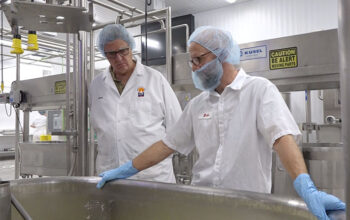The causes of poverty in Dane County are widely debated, with no single consensus existing in scholarly circles to explain it.

Individual factors, such as low education, lack of motivation or culture that supports economic instability, play a key role in getting people into poverty and keeping them there. But structural factors like the characteristics of the labor market and institutional discrimination are also central.
Lawrence Berger, a University of Wisconsin-Madison professor in the School of Social Work and Director of the Institute for Research on Poverty, suggests that in Dane County an amalgamation of both structural constraints and individual-level behaviors drive poverty.
“I think we really do know that it is a combination between structural or contextual factors and individual factors, including, part of it is the luck of who you are born to. If you are born to more educated or higher income parents or not,” Berger said. “I think the real answer is that it is a combination. In some ways, it's really hard to separate those out. Is being well educated a personal thing or does it stem from a context and a structure, right? It is both.”
According to Sarah Ceponis, director of United Way of Dane County’s Community Impact: Basic Needs, “We've seen over the course of decades and generations that there's been entrenched concerns for certain segments of the population and they are not able to get ahead. They are not able to acquire wealth and we know that the U.S. is one of the least upwardly mobile countries in the world,” Ceponis said. “They are born into a ZIP code that has extremely high rates of poverty, the likelihood of them staying very poor is really high.”
In other words, where people are born can predetermine their future financial situation and institutional discrimination only adds more obstacles to people struggling out of poverty. Jim Schroeder, executive director of the Community Action Coalition for South Central Wisconsin says “A lot of it is structural, having to do with quite frankly institutionalized racism. We know that a higher percentage of people of color are in poverty than the population as a whole."
Joe Parisi, the Dane County Executive, agrees.
“The situation that is the most challenging in Dane County, I would say, is intergenerational poverty,” said Parisi. “Folks who are in poverty, whose families have been in poverty for generations and the estrangement from what's accessible to those who aren't living in poverty that results from that. So there is an institutional intergenerational poverty that has many facets that are very challenging to address.”
People in poverty in Dane County are also suffering because wages have been stagnating for a long time in Wisconsin and even though the unemployment rate is low, many work jobs at poverty-level wages.
Wages in Dane County Lower than in 2000
The 2018 State of Working Wisconsin report by the Center on Wisconsin Strategy (COWS), a national think tank promoting solutions to social problems, stated that wages in the state have been stagnant over the last 40 years and income today is lower than it was in 2000.
“Low-wage jobs — indeed, low-wage careers — define and constrain the prospects of too many workers,” said the report.
The strong economy of Dane County doesn’t represent the fact that a large number of people are working in poverty-level jobs. The biggest problem in Wisconsin as a whole isn’t a lack of jobs, but the quality of those jobs.
According to the 2017 When Work is Not Enough report by COWS, the income problem isn’t solved by work alone, because a lot of jobs don’t offer enough for people to make ends meet — “they offer low wages, inadequate benefits and erratic scheduling.”
“The problem is not a lack of commitment to work among Wisconsin residents, but the persistent structural barriers to full, well-paying employment and inadequate or misdirected policy interventions that do not accommodate the realities of low-wage work,” said the report.
The low wages and lack of appropriate benefits packages can have a major influence on the financial stability of a family, which is one of the challenges that Dane County faces. Many of the jobs that are accessible to people living in poverty are “not really the ladder out of poverty” Parisi said.
The State of Working Wisconsin report placed the poverty-wage threshold at $11.95 per hour and it concluded that 18.22 percent of Wisconsin workers, or almost one in five, are at this level of income in 2017.
The Economic Policy Institute’s Family Budget Calculator, which measures the income a family needs in order to attain a modest yet adequate standard of living, estimates that the annual income for a family of two adults and two children should be $88,283. This is about $42.44 per hour if only one of the adults is working (assuming 40 hour weeks) — nearly four times the poverty-wage threshold.
For a single individual the Family Budget Calculator estimates that an annual income of $37,291 is necessary. This is $18 per hour, which is 50 percent more than the $11.95 poverty-wage set by COWS.
The COWS report stated that although wages are growing rapidly at the top of the income distribution, this is not the case for the middle and bottom of the labor market. The increasing inequality between the two opposite sides of the workforce makes it difficult for people in poverty-wage jobs to get ahead as the cost of living increases.
“The income inequality, the fact that so many people are doing well, and that we have a huge population growth, is driving the cost of housing etc.,” said Parisi. “So the folks who are doing well can afford that and folks living in poverty…it makes it even more difficult for them.”
Low wages aren’t the only problem, according to the When Work is Not Enough report. People in low-wage jobs often work “short and volatile hours, leaving workers with low income in part because they can’t get enough shifts.” This pushes people into working multiple jobs to be able to make ends meet.
“I think we don't have a good sense of are people working multiple jobs, what are the quality of those jobs, are they working all the hours that they'd want to be working,” Berger said. “A significant number of people would prefer to have one job at one wage and not have to work multiple jobs, and the employment rate doesn't say anything about that.”
The industries that have a disproportionate amount of poverty-wage jobs are the food service sector, retail, and residential and home healthcare, according to the When Work is Not Enough report.
“About 63 percent of workers in the food service sector, 48 percent in retail, and 41 percent in residential and home health care earn poverty wages,” said the report.
There is another issue for people that work poverty-wage jobs — these jobs aren’t careers. People working in industries like the aforementioned ones have little opportunity for growth and better wages.
Parisi noted that there are people looking for work and businesses looking for workers, but the two don’t cross paths. These trades have different paths into them, such as apprenticeships, but people aren’t aware of them.
“What I have seen, for example, from my vantage point is, we have an industry that needs people,” said Parisi. “At the same time we have a lot of people in our community who are struggling and looking for a career path and there are many.”




